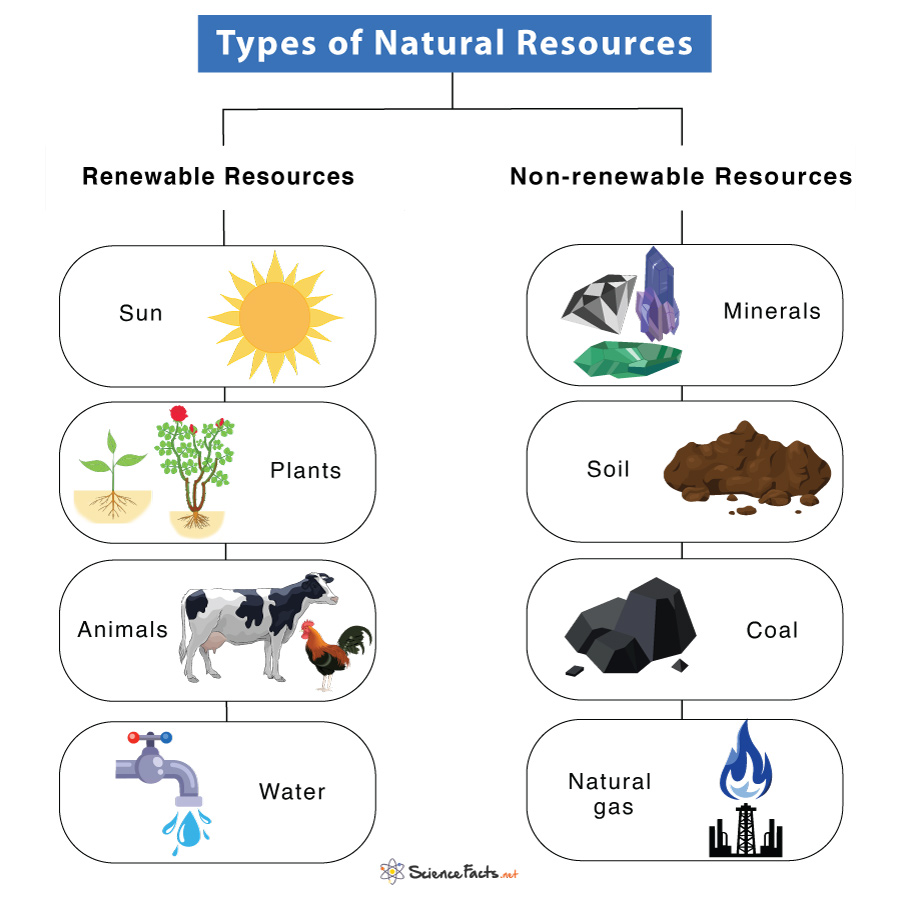What are Natural Resources
Natural resources are raw materials found on and below the Earth’s surface. They are naturally occurring materials formed without any human intervention.
Examples of Natural Resources
Earth’s most common natural resources are sunlight, air, water, soil, stone, plants, animals, and fossil fuels. They are essential for humanity to fulfill necessities like food, building, and clothing. They produce electricity, fuel for transportation, and make fertilizers.
However, items such as plastic goods, metal bodies, fabrics, and concrete are not natural resources but are obtained from them.
How Do We Use Natural Resources
Below are some significant natural resources found on Earth and how we use them for our needs.
| Natural Resource | Uses |
|---|---|
| Sunlight | The primary source of energy for all producers |
| Air | Wind energy |
| Water | Hydroelectric energy, drinking, and cleaning |
| Plants | Food, paper production, and clothing |
| Animals | Food (meat, milk, and cheese) and clothing (sweaters, leather products, and silk-made products) |
| Natural gas | Electricity and producing heat |
| Coal | Electricity |
| Petroleum | Energy in Transportation |
Types of Natural Resources
There are two ways of classifying natural resources.
Based on Their Availability
Natural resources are of two types, based on their availability.
1. Renewable Resources
Renewable resources are resources that are renewed during our lifetime. They are available to us in abundance. However, the rate at which they are renewed may differ. Sunlight, air, water, plants, and animals are some examples of renewable resources on Earth.
Renewable resources are of two types: perpetually renewable and intermediate renewable resources.
Perpetually renewable resources are constantly replenished by the Sun’s and Earth’s natural processes, no matter how much energy we use each day or over a period. Solar energy is the best example. Its energy is used for almost all activities, from plant-producing food to running a windmill or ocean currents.
In contrast, intermediate renewable resources last only if we use them judiciously. They are resources like freshwater used for drinking, the soil we live in, trees for timber, and plants and animals for food.
2. Non-renewable Resources
Non-renewable resources are those natural resources that cannot be readily renewed by natural means quickly enough. They are available in limited quantities and thus can get exhausted with time. Fossil fuels, such as coal, petroleum, heavy oils, and natural gas, are non-renewable resources.
Based on Their Source
Natural resources are of two types, based on their source:
1. Biotic Resources
Biotic resources are resources derived from the living things of the biosphere. They include plants, animals, and fossil fuels.
2. Abiotic Resources
Abiotic resources are resources obtained from nonliving and inorganic materials. Sunlight, air, water, and minerals like gold, silver, copper, and aluminum are all abiotic resources.
Why are Natural Resources Important
Natural resources are the source of food for all living organisms on Earth. Plants (autotrophs) are the primary natural resource on Earth for all other organisms (heterotrophs). Animals rely directly or indirectly on plants for their food. Some animals are also a food source for other animals, like lions prey on deer.
Both plants and animals provide raw materials for manufactured products. For example, leather bags and belts come from cows, cotton garments from plants, and silk garments from silkworms.
Natural resources like coal, natural gas, and oil provide electricity, run nuclear power plants, and are used as cooking fuel. Water is used to run thermal power plants.
Depletion of Natural Resources
Overutilization of non-renewable natural resources like coal, petroleum, and natural gas can deplete them faster due to their slow recovery rate. Thus, we must judiciously use and protect such resources so that they can last long. Also, we must replace them with renewable sources like solar, wind, and water for energy.
FAQs
Ans. No. Plastic is not a natural resource.
-
References
Article was last reviewed on Saturday, February 11, 2023




